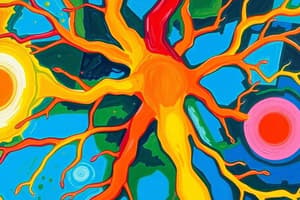Podcast
Questions and Answers
What is the primary function of the Central Nervous System?
What is the primary function of the Central Nervous System?
- To produce hormones
- To regulate growth and development
- To interpret and process information (correct)
- To transmit involuntary signals
Which part of the Peripheral Nervous System transmits sensory information?
Which part of the Peripheral Nervous System transmits sensory information?
- Sensory Nervous System (correct)
- Somatic Nervous System
- Autonomic Nervous System
- Central Nervous System
What is the function of Steroid Hormones?
What is the function of Steroid Hormones?
- To influence mood and behavior
- To regulate various bodily functions (correct)
- To maintain homeostasis
- To regulate metabolism
Which gland produces Peptide Hormones?
Which gland produces Peptide Hormones?
What is the main function of hormones?
What is the main function of hormones?
What is the Autonomic Nervous System responsible for?
What is the Autonomic Nervous System responsible for?
Flashcards
Central Nervous System (CNS)
Central Nervous System (CNS)
The central part of the nervous system, includes the brain and spinal cord. It analyzes information and controls actions.
Peripheral Nervous System (PNS)
Peripheral Nervous System (PNS)
Connects the CNS to the rest of the body via nerves and is divided into the Somatic, Autonomic, and Sensory Nervous Systems.
Hormones
Hormones
Chemical messengers made by endocrine glands that regulate bodily functions.
Steroid Hormones
Steroid Hormones
Signup and view all the flashcards
Peptide Hormones
Peptide Hormones
Signup and view all the flashcards
Amine Hormones
Amine Hormones
Signup and view all the flashcards
Study Notes
Nervous System
Central Nervous System (CNS)
- Consists of brain and spinal cord
- Interprets and processes information
- Controls voluntary actions
Peripheral Nervous System (PNS)
- Consists of nerves that connect CNS to rest of body
- Divided into:
- Somatic Nervous System: transmits voluntary signals
- Autonomic Nervous System: transmits involuntary signals
- Sensory Nervous System: transmits sensory information
Hormones
Definition
- Chemical messengers produced by endocrine glands
- Regulate various bodily functions
Types of Hormones
- Steroid Hormones:
- Produced by adrenal cortex and gonads
- Examples: estrogen, testosterone, aldosterone
- Peptide Hormones:
- Produced by pituitary gland and pancreas
- Examples: insulin, growth hormone
- Amine Hormones:
- Produced by thyroid gland and adrenal medulla
- Examples: thyroxine, epinephrine
Functions of Hormones
- Regulate growth and development
- Control metabolism
- Influence mood and behavior
- Regulate reproductive processes
- Maintain homeostasis
Nervous System
Central Nervous System (CNS)
- Consists of brain and spinal cord, interpreting and processing information
- Controls voluntary actions, such as movement and responses
Peripheral Nervous System (PNS)
- Comprises nerves connecting CNS to the rest of the body
- Divided into three subsystems:
- Somatic Nervous System: transmits voluntary signals for muscle movement
- Autonomic Nervous System: transmits involuntary signals for automatic functions
- Sensory Nervous System: transmits sensory information from senses to CNS
Hormones
Definition and Function
- Chemical messengers produced by endocrine glands, regulating various bodily functions
Types of Hormones
- Steroid Hormones: produced by adrenal cortex and gonads, examples include estrogen, testosterone, and aldosterone
- Peptide Hormones: produced by pituitary gland and pancreas, examples include insulin and growth hormone
- Amine Hormones: produced by thyroid gland and adrenal medulla, examples include thyroxine and epinephrine
Hormone Functions
- Regulate growth and development processes
- Control metabolism and energy production
- Influence mood and behavior
- Regulate reproductive processes and cycles
- Maintain homeostasis, a stable internal environment
Studying That Suits You
Use AI to generate personalized quizzes and flashcards to suit your learning preferences.




